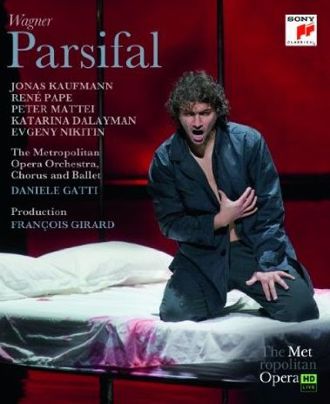|
|
|
|
|
|
|
|
|
Opera News, June 2014 |
| WILLIAM R. BRAUN |
|
|
|
WAGNER: Parsifal |
|
| |
 For
several years now, operas seem to be directed primarily for the
Live in HD audience rather than for the audience in the house.
Certainly this François Girard Parsifal offers an entirely
different experience on DVD from the effect it made inside the
Met. Some elements, such as the way Parsifal is positioned among
the choristers at curtain-rise, or the reappearance of Klingsor
to witness Kundry's kiss, were not visible from my seat on the
orchestra level. Designer Michael Levine's notorious lake of
blood for Act II was likewise unseen from some of the house. On
the other hand, some prominent features of the live event could
never be replicated on DVD, particularly the near-unbelievable
dynamic range of René Pape's Gurnemanz, the life-and-death
connection between Pape and the sensational conductor Daniele
Gatti, and the stunned silence in which the audience received
much of the performance. For
several years now, operas seem to be directed primarily for the
Live in HD audience rather than for the audience in the house.
Certainly this François Girard Parsifal offers an entirely
different experience on DVD from the effect it made inside the
Met. Some elements, such as the way Parsifal is positioned among
the choristers at curtain-rise, or the reappearance of Klingsor
to witness Kundry's kiss, were not visible from my seat on the
orchestra level. Designer Michael Levine's notorious lake of
blood for Act II was likewise unseen from some of the house. On
the other hand, some prominent features of the live event could
never be replicated on DVD, particularly the near-unbelievable
dynamic range of René Pape's Gurnemanz, the life-and-death
connection between Pape and the sensational conductor Daniele
Gatti, and the stunned silence in which the audience received
much of the performance.
But it seems to me that the
wrong question is being debated. The real question is whether
video directors presented with the elements of the performance
at hand view these as merely the materials with which to
construct something that calls attention to themselves. In this
case, the elements involved include Girard's deeply considered
viewpoint, performances from Pape, Peter Mattei and Jonas
Kaufmann that are unsurpassed in the world today, and Gatti's
tremendous knowledge of the score. The roving camera work here
even obscures important ideas in Girard's production, such as
the careful placement of groups of figures across the set and
the synchronized movements of the massed, white-shirted male
chorus. There is an electrifying moment when Mattei's Amfortas
first recalls the prophecy of the salvation of the knights and
the camera remains still for ten seconds, giving home viewers a
sense of the power of the moment in the house. Elsewhere,
however, characters seem to be gliding past on ice floes,
scenery seems to be moving, and characters who are moving at the
same speed as the camera seem to be standing still. The implied
message is that the final masterpiece of a genius composer and
the hard work of an excellent cast could never be expected to
hold our attention.
Yet the DVD can be recommended. Pape
is superb, even if a few notes betray that the performance
started at the ungodly hour of noon. Mattei has not only found
the beauty, the regret and the anguish in the music; he somehow
manages to combine all three in nearly every phrase. Kaufmann is
ideal for Girard's conception of Parsifal's emotional
maturation. Katarina Dalayman, whose words as Kundry were mostly
not intelligible in the house, makes a greater effect here
through microphone placement. Gatti weaves a seamless
performance that incorporates the dizziness of ecstasy, the
inexplicability of some silences, the ever-bizarre nature of
some moments in the music. But he nonetheless takes risks. He
almost (but not quite) beaches this huge vessel at Kundry's
appearance among the Flowermaidens; he inserts an effective long
silence before young Parsifal admits that he doesn't know his
name; and he dwells on the long seven-bar held note in the
violins as Gurnemanz recognizes the returned Parsifal in Act III
until it seems that the instruments may break. Girard's
production is particularly striking in Act III, showing us that
belief is difficult, almost impossible, and that even if
deliverance comes, it may not be at all what we expect. He
provides the audience with not only a representation but a
physical analogue of Parsifal's tortured path.
|
|
|
|
|
|
|
|
|
|
|
|
|
|
|
|
|
|
|